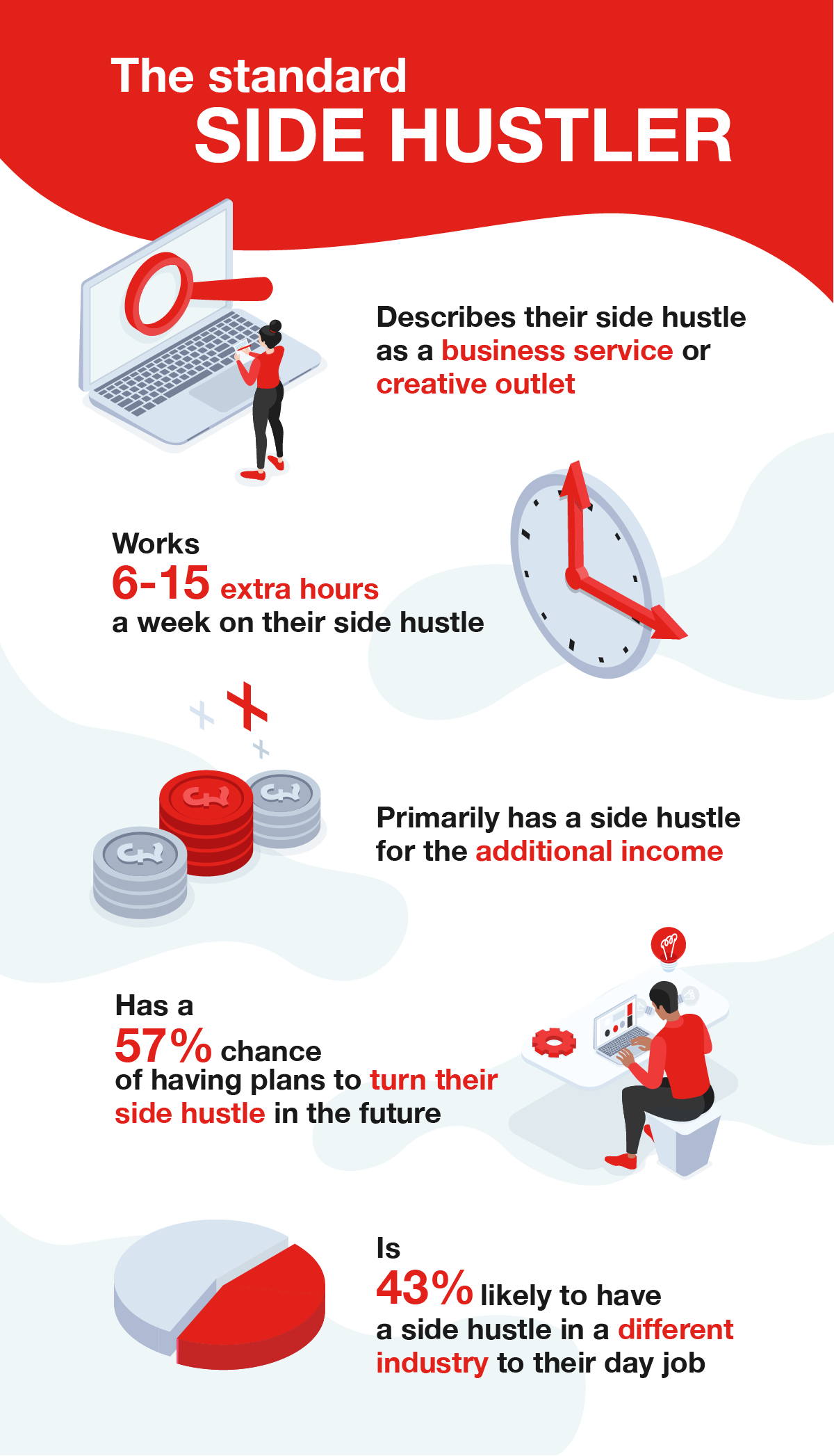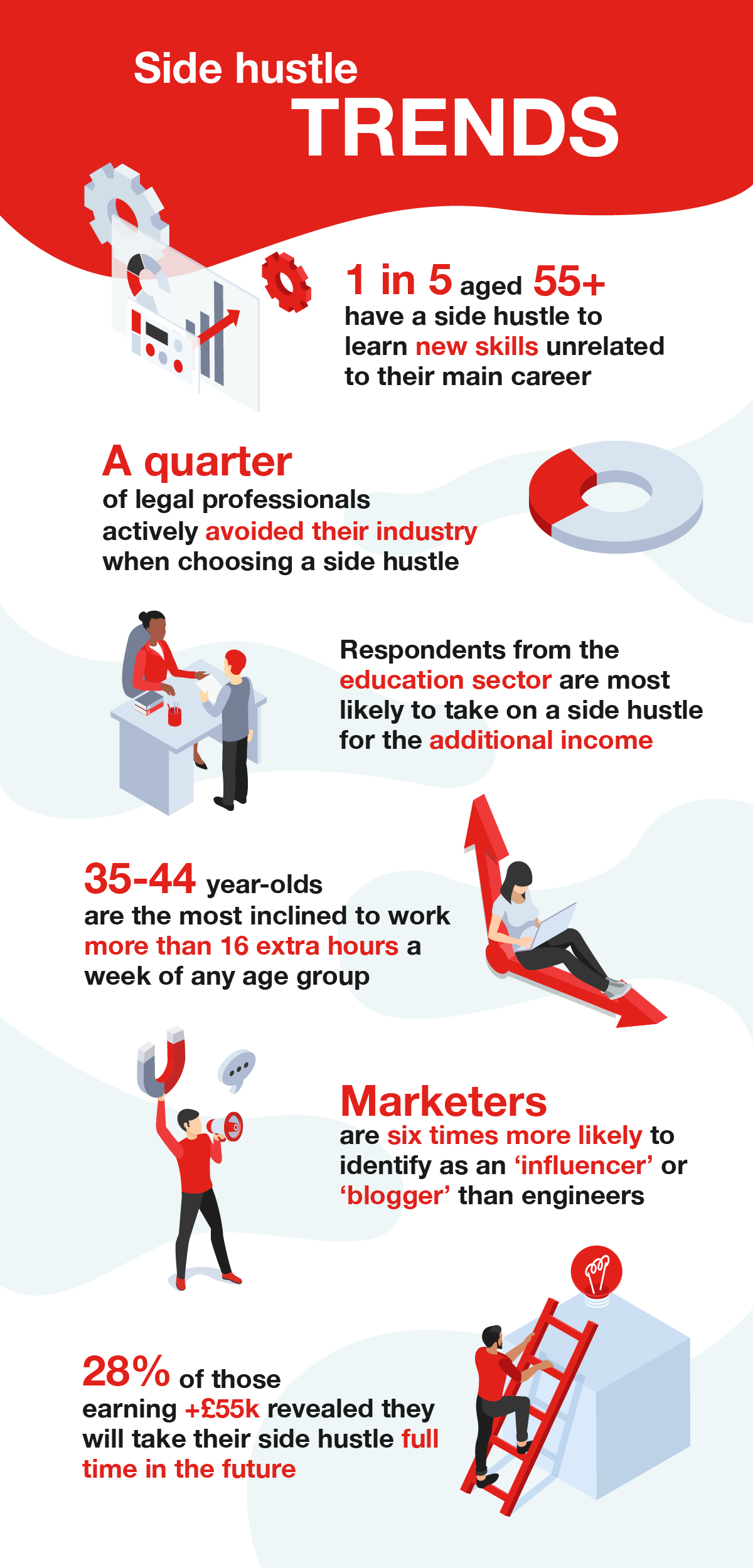

Whether it’s to earn a bit of extra cash or to keep up a hobby, it’s becoming more and more common for individuals in full-time employment to take on a ‘side hustle’ to complement their day job. 1 in 4 Brits do so, in fact, according to recent research [1].
Usually flexible in nature, these secondary projects can take many forms, from freelance work to selling handicrafts. And, while some do it to fulfil a dream of being their own boss, a side hustle doesn’t need to be a fully-fledged money-earner to serve a purpose. Side hustles can offer all sorts of benefits beyond the financial incentive, such as personal development and the opportunity to test the water in other industries, without sacrificing a job or steady pay cheque.
To gain a bit more insight into the growing side hustle culture, we surveyed hustlers from a variety of industries and age groups to find out what drives them to take on extra work beyond their full-time gig. Here’s what we unearthed.

The average ‘side hustler’ works an extra 6-15 hours a week
Bearing in mind these individuals are in full-time employment, our survey indicated that the average ‘side hustler’ puts an extra six to 15 hours of work a week into their secondary gig. Further to this, one in five work an extra 16-20 hours. Whether this is spread out across the week or isolated to weekends, that’s a pretty significant portion of their free time dedicated to the cause.
Side hustles aside, 2018 research found that British employees work an average of 469 extra unpaid hours a year [2] within their primary employment.
Those aged between 35-44 are the most inclined to work more than 16 extra hours a week of any of the age groups surveyed – that’s twice as likely as 16-24-year olds. They’re also the generation most probable to identify additional income as the main reason for their side hustle, something that may be correlative.
Industry wise, marketers and HR professionals work the most overtime, with 50% committing an extra 11-15 hours a week to their side-venture.
Once a side hustle, always a side hustle?
To gauge the intentions behind these side hustles, we asked whether they were only ever intended as a part-time project or if there’s scope to go full-time one day.
Sometimes what begins as a hobby can feel more and more like it has the potential to take off as a business in its own right. It could even result in discovering a true calling in life and realising that the career you’re in just isn’t providing the same level of excitement the side hustle does.
But, leaving the security and benefits of a steady role at an established company to pursue this kind of venture is a scary prospect, and it takes some serious confidence and drive to run a business. It’s also a strong possibility that the pressure to turn it into a money-maker could take away from the original enjoyment.
This being said, of our respondents, 57% said that they have plans to turn their side hustle into a full-time venture or would like to do so at some point in the future.
At a closer look, it’s the 25-34 age group that expressed the most interest in doing so, who are arguably at a stage of assessing their long-term career options, as opposed to in their first job or a long-established career. Architecture is the most entrepreneurial sector, with 29% of professionals confessing they want to make their side hustle a full-time venture
In contrast, a sixth of the side hustlers don’t feel that their second job would be a realistic source of income if it were full-time. 1 in 5 say their circumstances would have to change significantly to go full-time, including a fifth of education professionals – the highest proportion of respondents from any of the industries surveyed.
For passion or money? Two thirds have a side hustle for the extra income
There are many different motives behind starting a side hustle. The obvious impetus for carrying out extra work is to supplement monthly earnings; however, others start projects simply for the enjoyment they get out of it.
As expected, the additional income is the main ground for having a side hustle among our respondents, with two thirds stating this as their number one reason. Looking at industry trends, education professionals are the most disposed to take on a side hustle for the financial gain, of all sectors surveyed.
On the other hand, passion for a hobby was also pinpointed as something that inspires their motivation. Creative types in the arts & culture industry are the most inclined to start a passion project.
Also indicative that money isn’t the sole driving factor of side hustles, is the fact that respondents earning £15,000 or less a year are significantly more likely to have a side hustle for the love of the hobby than higher earners. In fact, they’re nearly four times more likely to identify passion as a reason for their secondary project than those earning £55,000 or more.
The ‘side hustle’ isn’t solely a millennial trend
Contrary to popular belief, the ‘side hustle’ isn’t simply a trend adopted by millennials. Lots of older people are also jumping on the band wagon – or, arguably, started the bandwagon many years ago.
Concordant with the other age groups surveyed, those aged 55 and over are most prepared to start a side hustle for the additional income, which could be held accountable the growing pressure to regularly supplement their pension pot or continue earning beyond retirement age.
According to the Office of National Statistics just under 1.2 million people over the age of 65 were still in work in the UK in 2018 [3], and further research has found that the number of employees expecting to work past 70 has doubled since 2010 [4].
It’s possible that taking on a side hustle later in life could be a means of putting more money aside for retirement – with low pension savings proving a big problem in the UK since the 2008 recession. For those who choose to continue in work after retirement age, a project like this could also pave the way to a more flexible set-up, if full-time hours are no longer possible or desirable.
Along with the additional income, the respondents aged 55+ said that one of the main reasons for taking on a side hustle was to learn new skills unrelated to their main career. Job-hopping and movement between industries is far more common today than it ever has before [5], so it’s possible that this age group are more likely to have spent a large portion of their working life in the same industry – or even company. Starting a side project is a valuable opportunity to branch away from the day job and try something beyond the comfort zone.

The most common types of side hustle are business services and creative outlets
Enough about why people have a side hustle. We wanted to know a bit more about what their side hustle is.
Results suggest that the most frequent form of secondary job is a business service (21.8%), such as freelance writing or design work, consultancy or training. Marginally in second place sits creative outlets (20.6%), encompassing arts & crafts, jewellery making and clothing. Other popular side hustles include part-time jobs, catering, events, driving and even blogging.
Being a ‘social media influencer’ or ‘blogger’ is a relatively new concept, though a select group of millennials have nailed the formula for turning it into a lucrative form of income. A fifth of our 16-24-year-old respondents fall under this category, more than any other age-group – though you probably could have guessed that.
Our survey also found that marketers are the most likely to identify as an influencer of blogger – six times more than engineers. While this isn’t ground-breaking news, manufacturing professionals aren’t far behind, with just short of 1 in 5 noting social media and blogging as their side hustle.
Which forms the perfect segue to our discovery that over half of our respondents’ side hustles are completely unrelated to their full-time industry. Travel & transport workers are the least prepared to take on additional work in the same sector, compared to IT professionals who are the most disposed to stick with what they know or enjoy.
Even more revealing is that a quarter of legal professionals actively avoid their industry when choosing a side hustle.
Whatever the nature or money-making potential, and whether it’s simply a means of making ends meet, or following a dream, it’s evident that the ‘side hustle’ plays a significant role in a lot of people’s lives.
While being self-employed can be incredibly rewarding, it doesn’t come without its risks and without the security of a company to support you, a professional mistake or an accident involving a member of the public could land you in hot water. Self-employed insurance is designed especially for those who work for themselves, to protect against the most common risks.
[1] https://www.henley.ac.uk/news/2018/side-business-is-big-business
[2] https://www.independent.co.uk/money/spend-save/uk-people-unpaid-work-hours-year-british-workers-a8266676.html
[3] https://www.bbc.co.uk/news/business-44042133
[4] https://www.independent.co.uk/money/spend-save/retirement-late-number-age-70-pension-work-longer-a8266461.html
[5] https://www.entrepreneur.com/article/311080
Disclaimer:
At Hiscox, we want to help your small business thrive. Our blog has many articles you may find relevant and useful as your business grows. But these articles aren’t professional advice. So, to find out more on a subject we cover here, please seek professional assistance.






